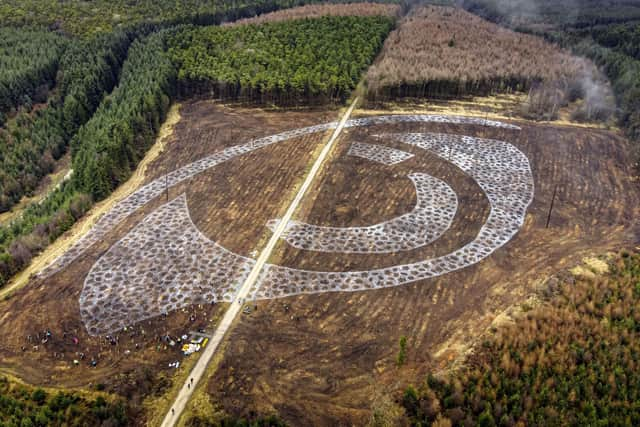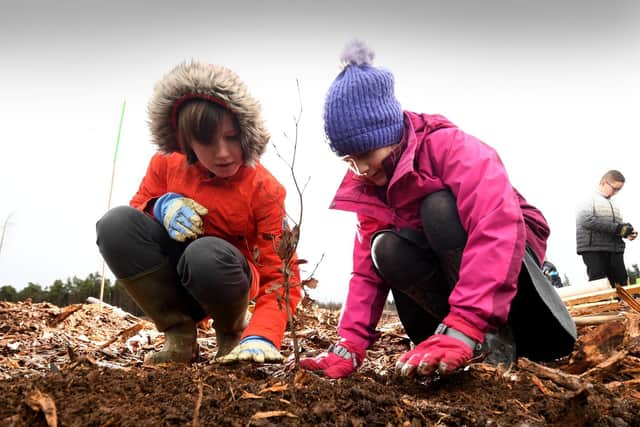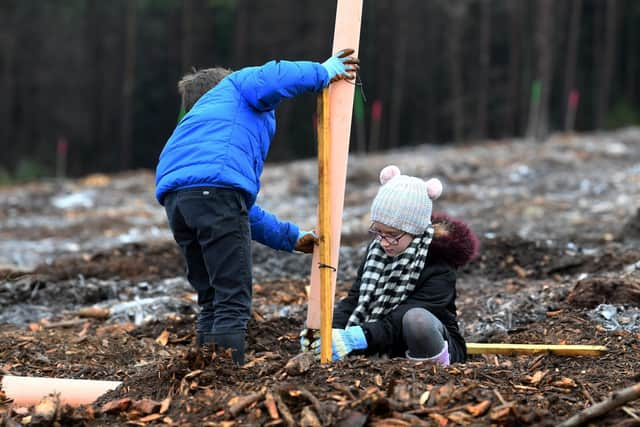North Yorkshire forest eyes challenge to tackle climate change with largest living woodland artwork in the country
Work began on Tuesday to plant the first trees for a giant forest eye in North Yorkshire to create the largest living woodland feature in England.
The 1,000ft-wide work in Dalby Forest, near Pickering, is being created with 5,000 beech, alder and maple trees in the shape of a child’s eye, focusing attention on climate change and showing the vital role that forests can play in tackling global warming.
Advertisement
Hide AdAdvertisement
Hide AdInternationally-renowned sculptors from the Hebden Bridge-based arts group, Sand In Your Eye, have been drafted in by Forestry England to create the vast feature, which will be visible from the air in six years as the trees mature.


More than 100 children from Thornton Dale and Kirkbymoorside primary schools were drafted in yesterday to help plant the initial wave of trees which are being introduced to create the Forest Eye.
Forestry England's director, Josephine Lavelle, said: “Hearing some of the children’s lively conversations today as they planted the very first trees to create this forest eye has reminded me of their deep understanding of the need to act now for nature’s recovery and their immense enthusiasm to be co-creators of a better future.
“Having the gaze of a child growing in the heart of this beautiful and ever-changing forest is a powerful symbol of how we need to listen and respond to the needs and vision of future generations.
Advertisement
Hide AdAdvertisement
Hide Ad“As the country’s largest land manager, we plan, plant and care for the nation’s forests and woodlands, thinking way beyond our own lifetimes to ensure forest landscapes flourish a hundred years ahead for people, wildlife and a sustainable economy.


“This wonderful living artwork embodies this important idea of today’s actions being guided by future needs.”
The broadleaf tree species of beech, alder and maple which will create the eye shape have been carefully selected to grow well in the soils on the site and are expected to thrive as the climate changes.
Once established, the forest eye will grow alongside the mixed broadleaf and conifer trees of Dalby Forest’s landscape providing habitat for wildlife including bats, birds and small mammals, as well as capturing carbon, improving air quality and offering a location for visitors to explore and connect with the natural world.
Advertisement
Hide AdAdvertisement
Hide AdSand In Your Eye’s artistic director, Jamie Wardley, said: “Our work is about prompting people to think deeply and respond emotionally to some of the biggest issues facing us all including the impacts of the climate crisis.


“We approached Forestry England and the Environment Agency to make an artwork that would combine climate science with art by using one of the very solutions, the physical landscape of the forest.”
Members of Sand In Your Eye are also hoping to embark on an even more challenging project to create a new forest in the UK.
Called the Forest of Humanity, it is hoped that the project will include the face of a young girl on the same scale as the Dalby Forest’s initiative - but this time measuring 1.25 miles across, which means it would be visible from space.
Advertisement
Hide AdAdvertisement
Hide AdDalby Forest, which welcomes 450,000 day visits each year, is already home to important contemporary artworks.
They include Rachel Whiteread’s Nissen Hut revealed in 2018, and the outdoor exhibition of Earth Photo, the international competition and exhibition created by Forestry England and the Royal Geographical Society showcasing photographs and videos documenting the natural world.
Under the stewardship of Forestry England, the nation’s 1,500 forests and woodlands are at the forefront of tackling the twin crises of climate change and biodiversity loss.
Ambitious work is under way on planting new woodlands across England, using more tree species that will be resilient to future climate conditions, and continuing to provide a sustainable supply of timber to contribute to a green economy.
Advertisement
Hide AdAdvertisement
Hide AdForestry England is aiming to create at least 5,000 acres of new woodland involving predominantly broadleaf tree species by 2026.
The organisation is also hoping to have a million hours of volunteer time given to the nation’s forests within the next four years.